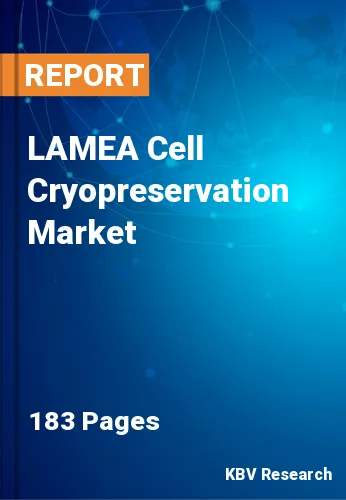The Latin America, Middle East and Africa Cell Cryopreservation Market would witness market growth of 23.1% CAGR during the forecast period (2023-2030).
Cryopreservation is the technique of freezing tissues and cells at low temperatures to keep the biological material metabolically inert, maintain its viability, and prevent ice crystal formation. Ice crystals are small crystals of ice that are formed when the temperature is extremely low. These can trouble the cell membrane of the cell or tissue, and the cell can die. Cells are cryopreserved to minimize genetic differences and prevent loss through contamination. Cryopreservation is used to preserve microorganisms, tissue cells, established cell lines, small multicellular organisms, and complex cellular structures such as embryos, nucleic acid, and proteins. Various types of medium or serum are used to freeze cells.
Glycerol and dimethyl sulfoxide (DMSO) are the most commonly used alternatives. Glycerol and dimethyl sulfoxide are mixed into a solution with serum or media in which cells are placed and frozen in a liquid nitrogen freezer. For cryopreservation, samples of tissues, cells, organelles, and other biological constructs are cooled to extremely low temperatures, i.e., -80 °C using solid CO2 or -196 °C using liquid nitrogen. Cryopreservation is generally utilized to protect the reproductive capacity of women with breast cancer during the in-vitro fertilization (IVF) cycle before treatment. Rapid advances in cellular therapy research, as well as the increasing use of cell therapies in a variety of illnesses, have resulted in a growing demand in the market.
According to the International Trade Administration, sales in 2021 will total $16.37 billion, a 14.26% increase from 2020. It is anticipated that sales will increase to $20 billion in 2022. The expansion of the pharmaceutical industry in Brazil reflects the importance of well-preserved biological materials in advancing drug development, biomedical research, and healthcare innovations. Cryopreservation services are crucial for supporting the diverse needs of the pharmaceutical sector as it strives to bring new therapies and medicines to the industry. The factors mentioned above will propel the market growth in this region.
The Brazil market dominated the LAMEA Cell Cryopreservation Market by Country in 2022, and would continue to be a dominant market till 2030; thereby, achieving a market value of $666.6 million by 2030. The Argentina market is experiencing a CAGR of 23.8% during (2023 - 2030). Additionally, The UAE market would exhibit a CAGR of 22.8% during (2023 - 2030).
Based on Component, the market is segmented into Consumables (Cryogenic Vials, Cryogenic Tubes, Cooler Boxes/Containers, and Others), Cell Freezing Media (Dimethyl Sulfoxide, Ethylene Glycol, Glycerol & Others), and Equipment (Freezers, Incubators, and Liquid Nitrogen Supply Tanks). Based on End-use, the market is segmented into IVF clinics, Biopharmaceutical & Pharmaceutical Companies, Biobanks, Research Institutes, and Others. Based on Application, the market is segmented into Stem Cells, Oocytes & Embryotic cells, Sperm Cells, Hepatocytes, and Others. Based on countries, the market is segmented into Brazil, Argentina, UAE, Saudi Arabia, South Africa, Nigeria, and Rest of LAMEA.
Free Valuable Insights: The Worldwide Cell Cryopreservation Market is Projected to reach USD 35.7 Billion by 2030, at a CAGR of 20.3%
The market research report covers the analysis of key stake holders of the market. Key companies profiled in the report include Merck KGaA, Thermo Fisher Scientific, Inc., Sartorius AG, PromoCell GmbH, Lonza Group Ltd., HiMedia Laboratories Pvt. Ltd., Corning Incorporated, BioLife Solutions, Inc., Eppendorf SE and Danaher Corporation.
By Component
By End-use
By Application
By Country
Our team of dedicated experts can provide you with attractive expansion opportunities for your business.

